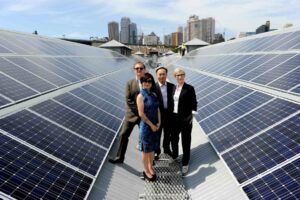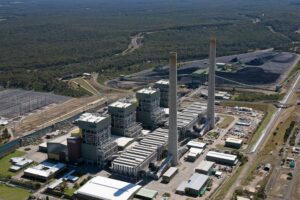Energy ministers are gearing up for a fight over the future of the National Electricity Market, with growing dissent over proposed market reforms and the future of fossil fuels in Australia’s energy system.
Federal, state and territory energy ministers will convene on Friday for their first major meeting since the Energy Security Board unveiled its proposed re-design of the National Electricity Market.
The proposed reforms include two controversial measures – the creation of a capacity market to financially reward ‘dispatchable’ generators, and likely to benefit legacy coal and gas plants, as well as a ‘congestion management model’ to regulate how new projects join the grid.
The clean energy industry has variously labelled the two reforms as CoalKeeper and SolarStopper, respectively, due to the potential treat of keeping coal power stations open for longer and to stymie future investments in new solar, wind and storage projects.
Energy ministers from the two largest states, New South Wales and Victoria, have both flagged their intention to forge their own path on managing the retirement of their state’s of thermal generators – and have called for a greater focus on ‘flexible’ generation, including battery storage.
Both states have a preference for entering into direct negotiations with coal plants around their planned closure – which Victoria has already done with EnergyAustralia’s Yallourn power station – over the Energy Security Board’s proposal to create a market-wide capacity mechanism.
They were joined by ACT energy minister Shane Rattenbury, who confirmed on Thursday that the ACT would “adamantly oppose” the introduction of subsidies that would extend the lives of coal and gas power stations, and joined a call for the ESB’s reforms to focus on zero emissions technologies.
The Morrison government has rallied behind the Energy Security Board’s proposal for a capacity market, with federal energy minister Angus Taylor arguing that such a mechanism was necessary to prevent the early closure of coal plants.
Writing in the Financial Review ahead of the energy minister’s meeting, Taylor argued that a capacity market would provide greater transparency around how financial support might be directed to coal plants to prevent unexpected and early closures.
“This is a transparent approach to secure the market, in contrast to alternative arrangements like bespoke, opaque deals with coal generators to keep them in the market, with unknown, direct costs to taxpayers,” Taylor wrote.
Speaking to the The Driven podcast ahead of the meeting of energy ministers, New South Wales energy minister Matt Kean said he agreed that Taylor and the Energy Security Board had identified the right challenge facing the energy market.
However, Kean added that he saw the direct negotiation of arrangements with individual energy companies as providing the most workable way forward in terms of dealing with looming coal plant closures.
“Minister Taylor and the ESB have identified the right problem that we need to solve and that is how do you keep existing infrastructure in long enough to ensure that the replacement kit is built?” Kean told The Driven podcast.
“But New South Wales believes that the best way to deal with existing coal would be to negotiate bespoke arrangements with the different operators have those assets – being Origin, AGL, EnergyAustralia and Delta Energy in New South Wales. That’s what our preference would be.”
“That way we have more control as to when we could manage those exits in a responsible way.”
Kean added that he was confident that Taylor and the Energy Security Board would be able to respond to the concerns of State and Territory governments, which may include allowing individual states to opt-in or opt-out of any future capacity mechanism.
Victorian energy minister Lily D’Ambrosio has expressed similar desires, with the Victorian government already seeking to support investment in new renewable energy projects to ensure adequate replacement capacity is built, ahead of expected closures of coal-fired power stations.
Neither state wants to see energy energy consumers lumped with the costs of both a capacity mechanism and the bilateral deals already being signed with generators that provide the financial support needed to prevent an early closure, while also locking in a concrete date of their decommissioning.
ACT minister Shane Rattenbury said on Thursday that he had written to other energy ministers ahead of their meeting to suggest amendments to the ESB’s proposed forms, to ensure that they did not work to keep coal plants operating beyond their anticipated closure date.
While Rattenbury does not need to deal with the same issues as other states – as the ACT is not host to any coal fired generators – the ACT government has introduced significant measures to decarbonise the territory’s energy supplies, including purchasing 100 per cent renewable electricity on behalf of ACT consumers.
Rattenbury has called for any capacity mechanism to apply only to zero emissions technologies – excluding its application to coal and gas plants.
“I have written to all other Energy Ministers proposing essential amendments to guidelines if further work is to be done by the ESB,” Rattenbury said on Thursday.
“It is vital that Energy Ministers are absolutely clear in their instructions to the ESB that we expect the market bodies to undertake any reform in a way that rapidly reduces emissions from Australia’s electricity sector.”
“The current guidelines leave too much to chance – we have to be definitive what future they are taking us towards. The target must be a 100% renewable energy system so that we can address climate change and help achieve state and territory commitments of net zero emissions by 2050 at the latest.”
Rattenbury added that he would push for a re-examination of the National Energy Objectives, with a view to ensuring decarbonisation was included as a priority.
“Debate over this possible capacity mechanism once again demonstrates the need for de-carbonisation aims to be incorporated into the National Electricity Objectives (NEO). Without this, it is impossible to have coherent market arrangements that provide appropriate investment certainty and deliver the outcomes that all states and territories have committed to,” Rattenbury added.
Queensland minister for energy, renewables and hydrogen, Mick de Brenni, also indicated that he would only back a proposal that did not interfere with the state’s renewable energy ambitioons.
“Specific positions are National Cabinet in-confidence however, Queensland will only support recommendations that enable our state to meet our renewable energy and zero emissions targets and deliver cheap, clean and reliable power for Queenslanders,” de Brenni told RenewEconomy.
Since it released the details of its proposed reforms, the Energy Security Board has gone to great lengths to stress that its proposed re-design of the National Electricity Market remains a work in progress – even after several years of work.
This raises the likelihood that the meeting of energy ministers will come away with an agreement to continue that work, with final designs as long as 18 months away.
In late news, EnergyAustralia has announced that it will bring forward the closure date of the 1,400 Mt Piper coal-fired power station by three years, as it plans to exit coal generation altogether by 2040. A move likely to put pressure on energy ministers to agree to measures to prevent early coal plant closures.








